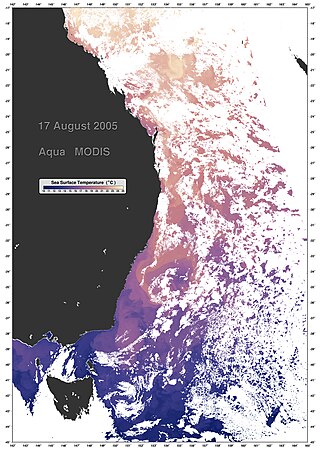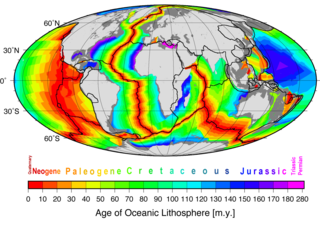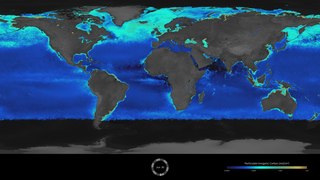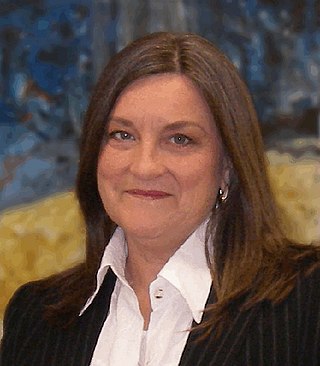
The Drake Passage is the body of water between South America's Cape Horn, Chile, Argentina and the South Shetland Islands of Antarctica. It connects the southwestern part of the Atlantic Ocean with the southeastern part of the Pacific Ocean and extends into the Southern Ocean. The passage is named after the 16th-century English explorer and privateer Sir Francis Drake.
Warren White is a professor emeritus, and a former Research Oceanographer at the Marine Biological Research Division at Scripps Institution of Oceanography at UC San Diego.
High-nutrient, low-chlorophyll (HNLC) regions are regions of the ocean where the abundance of phytoplankton is low and fairly constant despite the availability of macronutrients. Phytoplankton rely on a suite of nutrients for cellular function. Macronutrients are generally available in higher quantities in surface ocean waters, and are the typical components of common garden fertilizers. Micronutrients are generally available in lower quantities and include trace metals. Macronutrients are typically available in millimolar concentrations, while micronutrients are generally available in micro- to nanomolar concentrations. In general, nitrogen tends to be a limiting ocean nutrient, but in HNLC regions it is never significantly depleted. Instead, these regions tend to be limited by low concentrations of metabolizable iron. Iron is a critical phytoplankton micronutrient necessary for enzyme catalysis and electron transport.

The East Australian Current (EAC) is a warm, southward, western boundary current that is formed from the South Equatorial Current (SEC) crossing the Coral Sea and reaching the eastern coast of Australia. At around 15° S near the Australian coast the SEC divides forming the southward flow of the EAC. It is the largest ocean current close to the shores of Australia.
Lynne Talley is a physical oceanographer at Scripps Institution of Oceanography known for her research into the large-scale circulation of water masses in the global ocean.

Haskell Strait refers to the ocean passage in southern McMurdo Sound, running between Cape Armitage, Ross Island and Cape Spencer-Smith, White Island, Antarctica. Oceanographically, it separates McMurdo Sound from the ocean basin beneath the Ross Ice Shelf. The Strait itself is around 25 km wide and in places over 900 m deep. Currents of nearly half a knot have been measured in the Strait, although typical flows are lower. It is mostly covered by the ice of the McMurdo Ice Shelf and fast ice in southern McMurdo Sound. On rare occasions sea-ice breakout exposes the north-west corner of the Strait which becomes navigable and vessels can actually moor off Scott Base.
Kathleen (Kathy) Crane is an American marine geologist, best known for her contributions to the discovery of hydrothermal vents on the Galápagos Rift along the East Pacific Rise in the mid-1970s.
CICE is a computer model that simulates the growth, melt and movement of sea ice. It has been integrated into many coupled climate system models as well as global ocean and weather forecasting models and is often used as a tool in Arctic and Southern Ocean research. CICE development began in the mid-1990s by the United States Department of Energy (DOE), and it is currently maintained and developed by a group of institutions in North America and Europe known as the CICE Consortium. Its widespread use in earth system science in part owes to the importance of sea ice in determining Earth's planetary albedo, the strength of the global thermohaline circulation in the world's oceans, and in providing surface boundary conditions for atmospheric circulation models, since sea ice occupies a significant proportion (4-6%) of earth's surface. CICE is a type of cryospheric model.

Amelia E. Shevenell is an American marine geologist who specializes in high-latitude paleoclimatology and paleoceanography. She is currently a Professor in the College of Marine Science at the University of South Florida. She has made notable contributions to understanding the history of the Antarctic ice sheets and published in high-impact journals and, as a result, was awarded full membership of Sigma Xi. She has a long record of participation in international ocean drilling programs and has served in leadership positions of these organizations. Shevenell served as the elected Geological Oceanography Council Member for The Oceanography Society (2019-2021).
M. Joan Alexander is an atmospheric scientist known for her research on gravity waves and their role in atmospheric circulation.

Marine geophysics is the scientific discipline that employs methods of geophysics to study the world's ocean basins and continental margins, particularly the solid earth beneath the ocean. It shares objectives with marine geology, which uses sedimentological, paleontological, and geochemical methods. Marine geophysical data analyses led to the theories of seafloor spreading and plate tectonics.
Eddy saturation and eddy compensation are phenomena found in the Southern Ocean. Both are limiting processes where eddy activity increases due to the momentum of strong westerlies, and hence do not enhance their respective mean currents. Where eddy saturations impacts the Antarctic Circumpolar Current (ACC), eddy compensation influences the associated Meridional Overturning Circulation (MOC).
Anne Ritger Douglass is atmospheric physicist known for her research on chlorinated compounds and the ozone layer.

The Great Calcite Belt (GCB) refers to a region of the ocean where there are high concentrations of calcite, a mineral form of calcium carbonate. The belt extends over a large area of the Southern Ocean surrounding Antarctica. The calcite in the Great Calcite Belt is formed by tiny marine organisms called coccolithophores, which build their shells out of calcium carbonate. When these organisms die, their shells sink to the bottom of the ocean, and over time, they accumulate to form a thick layer of calcite sediment.
Rachel Abercrombie is a seismologist at Boston University known for her research on the process of earthquake ruptures.
Jennifer Logan is an atmospheric scientist known for her research on how human activities influence the atmosphere, particularly with respect to biomass burning and the ozone hole.

Patricia Reiff is an American space physicist at Rice University, known for her research on space weather and for engaging the public about science.
Marika Holland is a scientist at the National Center for Atmospheric Research known for her work on modeling sea ice and its role in the global climate.
Mary-Louise Elizabeth Timmermans is a marine scientist known for her work on the Arctic Ocean. She is the Damon Wells Professor of Earth and Planetary Sciences at Yale University.
Phyllis Jean Stabeno is a physical oceanographer known for her research on the movement of water in polar regions. She has led award-winning research projects in the Arctic and was noted for a distinguished scientific career by the National Oceanic and Atmospheric Administration.






